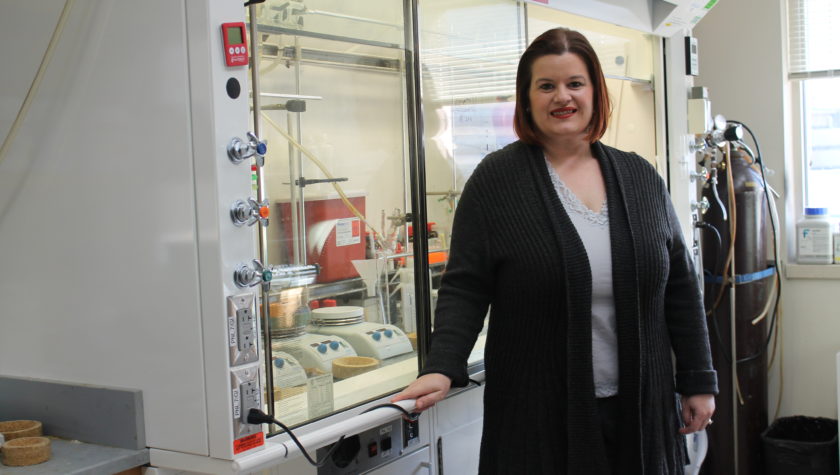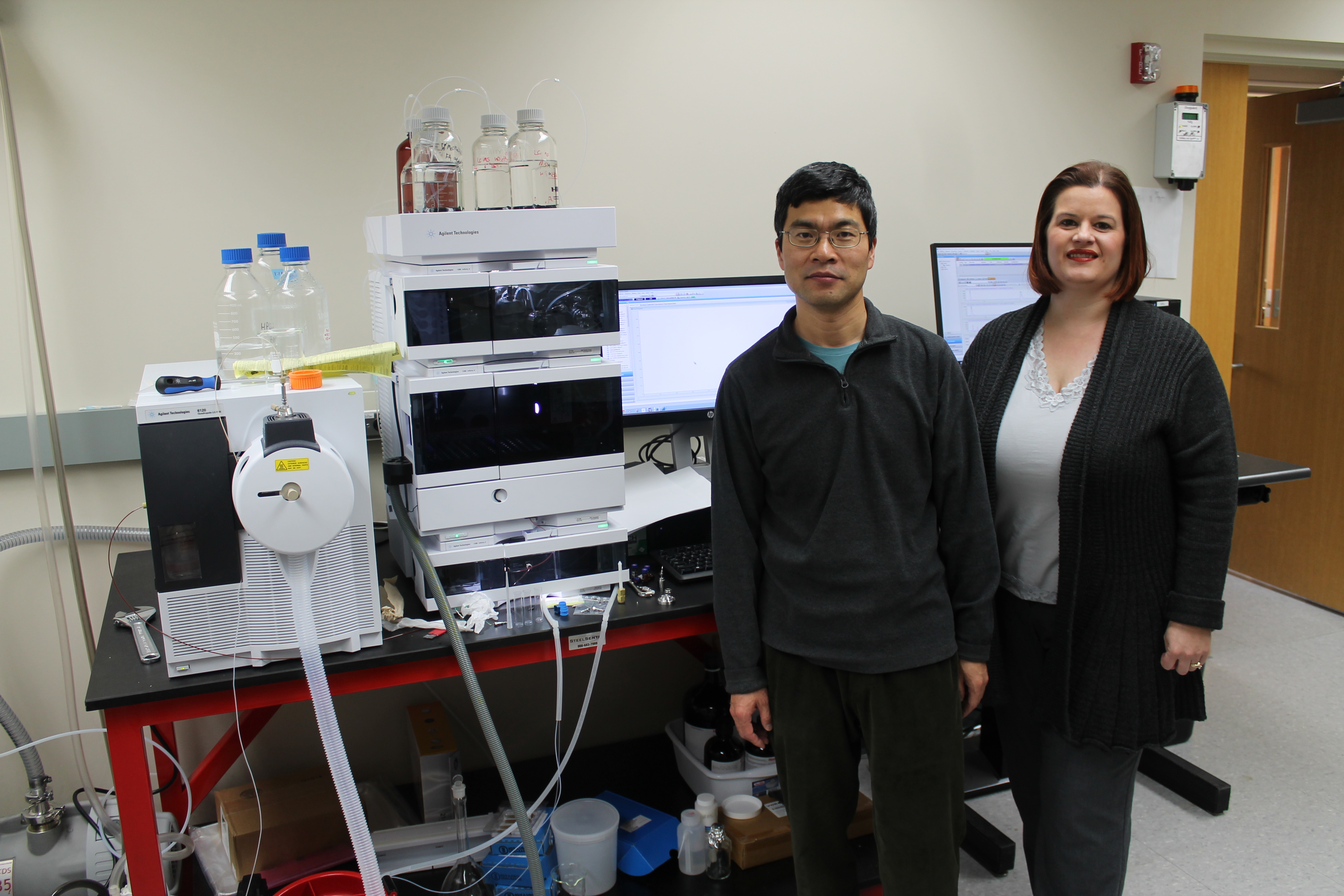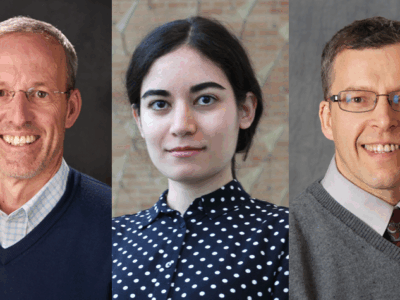
7
June

Jennifer Golden builds chemistry-centered collaborations to design and deploy new drug-like compounds to address pressing biological questions
By Jill Sakai
Early medicines came from nature — salicylic acid from willow bark, penicillin from a mold, cancer-fighting taxanes from yew trees. Through decades of study, scientists have learned not only what makes such molecules effective, but also how to tweak natural compounds and even to create new drug-like molecules from scratch.
As a medicinal chemist in the University of Wisconsin–Madison School of Pharmacy, Jennifer Golden draws on her extensive knowledge of how chemical structures interact with living systems to design and build custom molecules tailored to exhibit specific kinds of biological activity. In the hands of the right scientist, she says, each of her compounds is a potential answer to a biological question. The trick is matching the questions to the right answers.
For that, she relies on an ever-growing network of life scientists across the country in a wide array of fields including virology, parasitology, cancer biology and genetics.
“My collaborators are experts in their respective fields of biology. We learn from each other, and it is essential that these relationships evolve from a fusion of expertise from different disciplines,” says Golden, who is an assistant professor of pharmaceutical sciences and associate director of the School’s Medicinal Chemistry Center. “That’s how we build a better compound.”
Better by design
The first step in this chemical matchmaking is engineering unique molecules. The Golden Lab starts with a chemical backbone, or scaffold, then builds up a molecule by adding groups of atoms known to function together in certain ways. Some might enable the final molecule to pass through a cell membrane more readily, for example, or improve its stability in the human body. Others may affect how it behaves in different biological environments, such as at various pH levels. Yet other portions of the molecule may permit specific targeting of a pathogen or a cancerous cell while sparing normal cells.
At every step, Golden and her team must consider how the different chemical groups will behave in various contexts and what characteristics each may bestow on the final compound.
“Because we persisted, our work revealed all sorts of new chemistry that is fueling the next wave of new molecules to be screened.”
–Jennifer Golden
“Compounds of interest are interrogated deeply to understand the good, the bad and the ugly,” she says. “Using various tests, we identify any issues with a compound, and then structurally modify it to alleviate those liabilities.” Through iterative testing and refining, they find the molecules that offer promising combinations of chemical, biological and pharmaceutical parameters.
Feedback — in the form of data from the collaboration — helps her tweak the structures to enhance the positive features and fix negative ones. Gradually, they work toward the best possible chemical answers to their questions, whether that’s how to eradicate a parasite or protect us against a virus. And along the way, she says, they’re always creating new chemistry.
Bridging chemistry and biology
Before joining the School of Pharmacy, Golden worked at a pharmaceutical company for several years, then in a government-commissioned position at a university to guide early-stage drug discovery. In both positions, she developed new compounds and chemistry while working directly with biologists to address critical questions. Now, as a full-fledged academic, she enjoys being able to use synthetic and medicinal chemistry in support of drug discovery education and research efforts.
“A huge draw to UW was that investigators were asking what scientific progress could be made if they had the right molecule in hand,” she says. “People here are very interested in how they can leverage chemistry for their biology program.”
At UW–Madison, she is working on a project with Laura Knoll, a professor of medical microbiology and immunology, to design compounds that are effective against a parasite that causes toxoplasmosis, a type of foodborne illness that in severe cases can cause brain damage or death. Although there’s an existing treatment for the active form of the parasite, Toxoplasma can adopt a latent cyst form that the drug misses.
“Essentially that parasite can go into hiding, and emerge under extreme circumstances,” Golden says. “An infected person lives with that infection for the rest of his or her life.”
“It is essential that these relationships evolve from a fusion of expertise from different disciplines.” –Jennifer Golden
So far they’ve found compounds that, in the lab, show promising potency against both forms of the infection, she says. “Our goal is to clear out the parasite completely.”
She also has active projects working on several other human parasites, including the organisms that cause African sleeping sickness and leishmaniasis, and even a rare brain-eating amoeba.
A powerful antiviral
Her largest efforts currently, however, are focused on a family of emerging viruses called equine encephalitis viruses, or EEVs. These rare but potentially deadly viruses can infect people through the bite of an infected mosquito and can lead to encephalitis, or inflammation of the brain, with effects ranging from relatively mild flu-like symptoms to neurological impairment, seizures or, in serious cases, death. The most severe of the three EEVs, Eastern equine encephalitis virus, is associated with a mortality rate of 50 to 75 percent. Currently, however, there is no treatment.
Earlier this year, Golden and her colleagues, Colleen Jonsson of the University of Tennessee Health Science Center and Donghoon Chung of the University of Louisville, received a $21 million grant from the National Institutes of Health to establish a new Center of Excellence for Encephalitic Alphavirus Therapeutics to tackle this unmet need.
“Our goal is to produce a compound that is able to protect against and potentially treat EEV infections. With this support, we will hopefully advance a compound from the preclinical stage toward clinical candidacy,” Golden says.
This latest milestone is a culmination of many years of collaboration. Over time, the team has assessed several hundreds of molecules designed in Golden’s lab and refined the most promising, ultimately yielding a broad-spectrum antiviral that can suppress viral replication. “These are the only compounds we know of that interfere with this particular viral target and with this level of efficacy,” Golden says.
One of the compounds shows promising protection in mice against EEV infection and death, the team reported this year in a study published in Antiviral Research. Golden is now working with WARF to patent a newer compound series with exceptional promise, with an eye to advancing it toward human clinical trials.

“I love this project as an educational tool,” she says. “We’ve developed a novice hit compound from an early stage to a drug-like entity that is in lead development.”
Even the “misses” along the way have provided useful information about the structures that they have leveraged for other projects, she notes. “Not every compound we make will be a hit in the assays, and that’s okay,” Golden says. “They just haven’t found their target yet.”
That’s one luxury of being at an academic institution like UW–Madison, she says. In the pharmaceutical industry, there are more decision points where a project may be stopped if the progression is slower than anticipated or the trajectory changes.
“Here, our primary goal is training synthetic chemists to be great problem solvers. Drug development is somewhat secondary,” she says. “The focus is more on teaching the chemistry fundamentals and letting students experience what is involved in the drug development process.”
Her lab’s projects give students real-world examples to work with as they learn the thought processes, decision-making and problem-solving necessary in careers in pharmaceutical sciences, she says.
And the emphasis on education gives her a bit more freedom to pursue projects she might not have during her time in industry — projects that sometimes lead to unexpected discoveries, as in a recent one that initially wasn’t producing the hoped-for results.
“In industry, the project would have been dropped,” she says. “But because we persisted, our work revealed all sorts of new chemistry that is fueling the next wave of new molecules to be screened.”
Read more about Dr. Golden’s new $21 million grant from the National Institutes of Health to establish a Center of Excellence for Encephalitic Alphavirus Therapeutics.
Learn more about the School’s Medicinal Chemistry Center.




